Module 5 Unit 2 If you ever go to London,make sure you visit the Science Museum.课件(共28张PPT) 外研(新标准)版
文档属性
| 名称 | Module 5 Unit 2 If you ever go to London,make sure you visit the Science Museum.课件(共28张PPT) 外研(新标准)版 | 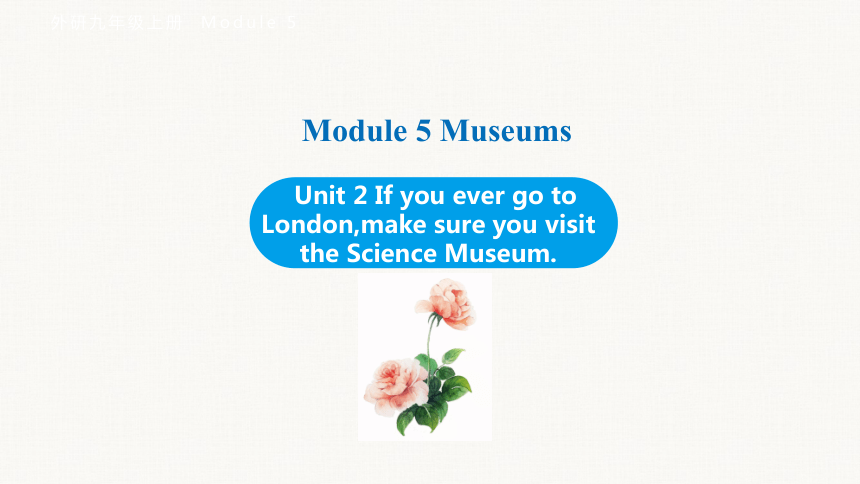 | |
| 格式 | pptx | ||
| 文件大小 | 28.2MB | ||
| 资源类型 | 教案 | ||
| 版本资源 | 外研版 | ||
| 科目 | 英语 | ||
| 更新时间 | 2024-05-14 14:20:54 | ||
图片预览

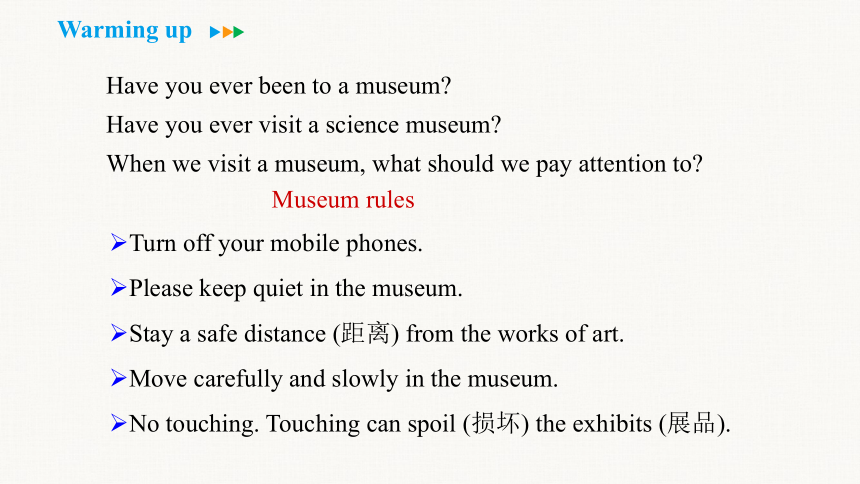
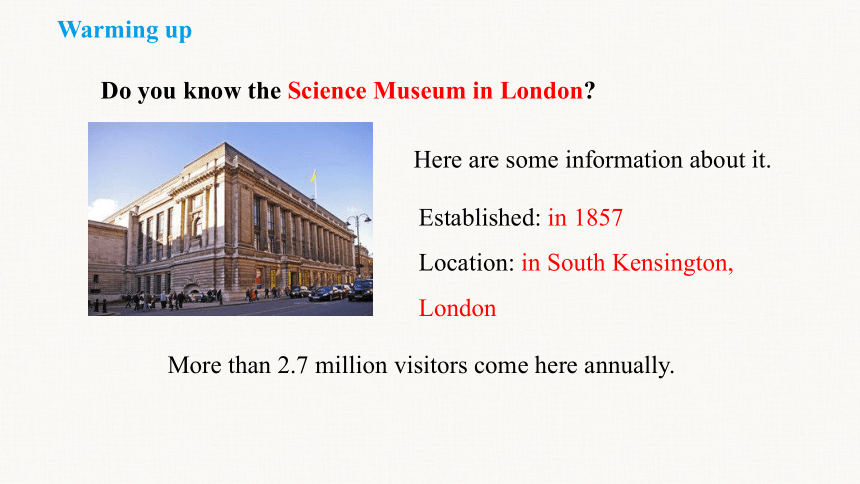
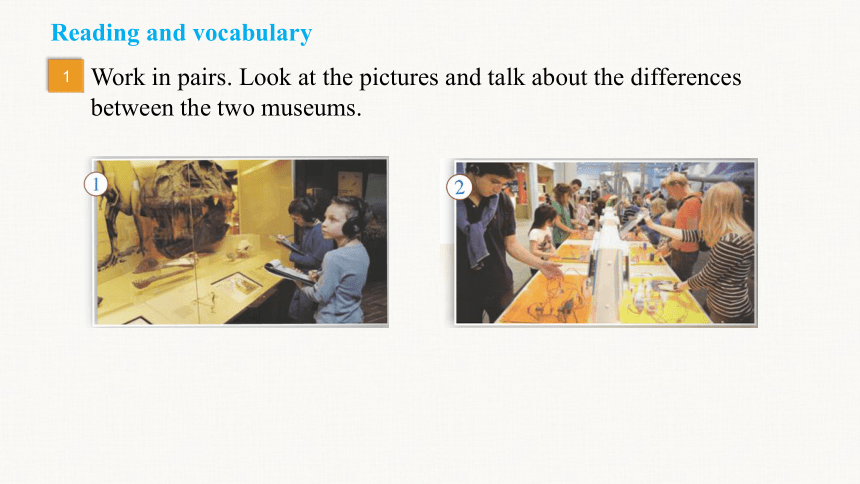
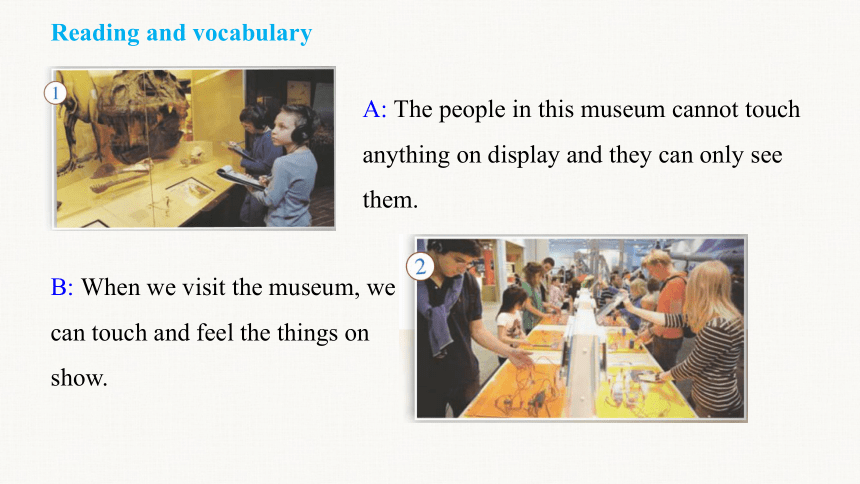
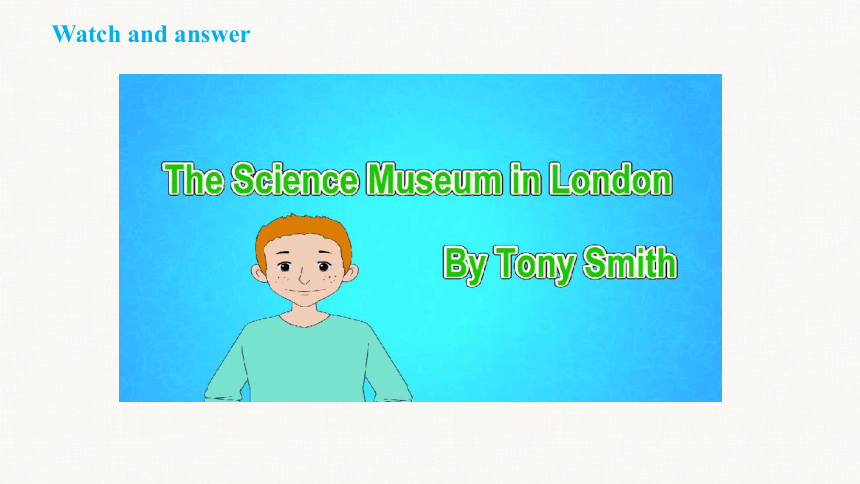
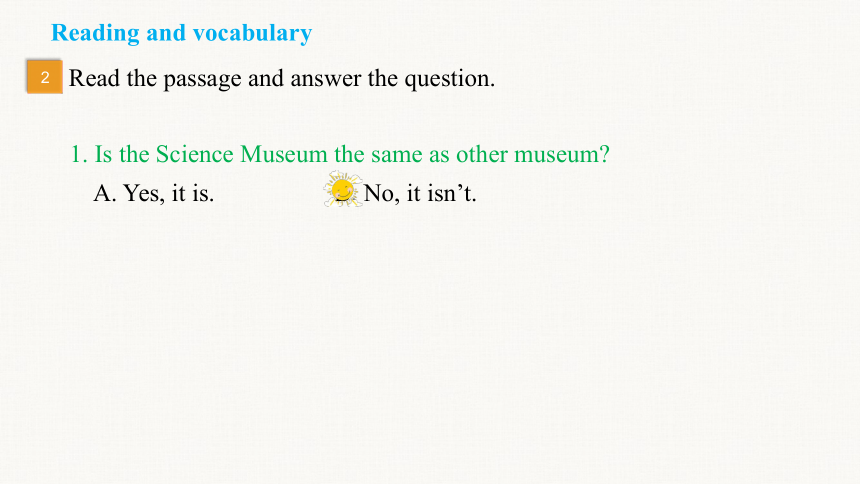
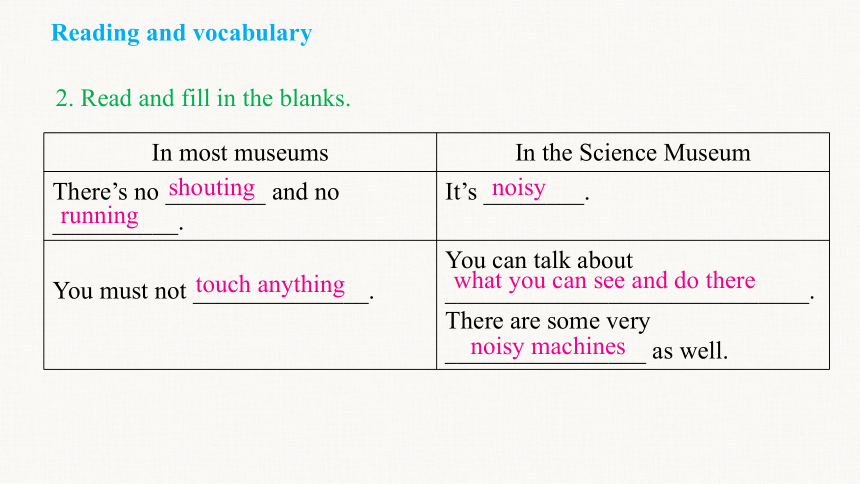
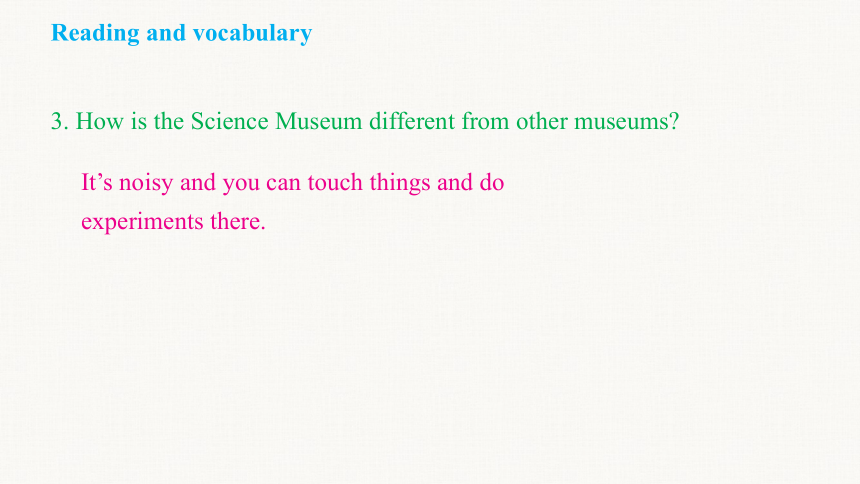
文档简介
(共28张PPT)
Module 5 Museums
外研九年级上册 Module 5
Unit 2 If you ever go to London,make sure you visit the Science Museum.
Warming up
Have you ever been to a museum
Have you ever visit a science museum
When we visit a museum, what should we pay attention to
Turn off your mobile phones.
Please keep quiet in the museum.
Stay a safe distance (距离) from the works of art.
Move carefully and slowly in the museum.
No touching. Touching can spoil (损坏) the exhibits (展品).
Museum rules
Do you know the Science Museum in London
Established: in 1857
Location: in South Kensington, London
More than 2.7 million visitors come here annually.
Here are some information about it.
Warming up
Reading and vocabulary
Work in pairs. Look at the pictures and talk about the differences between the two museums.
1
A: The people in this museum cannot touch anything on display and they can only see them.
B: When we visit the museum, we can touch and feel the things on show.
Reading and vocabulary
Watch and answer
Read the passage and answer the question.
1. Is the Science Museum the same as other museum
A. Yes, it is. B. No, it isn’t.
2
Reading and vocabulary
In most museums In the Science Museum
There’s no ________ and no __________. It’s ________.
You must not ______________. You can talk about _____________________________.There are some very ________________ as well.
shouting
running
touch anything
noisy
what you can see and do there
noisy machines
2. Read and fill in the blanks.
Reading and vocabulary
3. How is the Science Museum different from other museums
It’s noisy and you can touch things and do experiments there.
Reading and vocabulary
The Science Museum in London
By Tony Smith
Welcome to the most friendly museum in London. In most museums, there is no shouting and no running, and you must not touch anything. But the Science Museum is different... It is noisy! People talk about what they can see and do here, and there are some very noisy machines as well. If you want answers to all your questions about science, this is the right place for you.
I like to visit the rooms on the second and third floors. You can learn about communications and the environment as well as maths, physics and chemistry. For example, you can find out how people dig coal from the ground and use it to create energy. And in one room they even explain how X-rays let you see inside your body.
Reading and vocabulary
The Launchpad on the third floor is the most popular room, and it is my favourite too because there are lots of physics experiments. For example, if you want to fill a bag with sand, you have to control a kind of truck on wheels and move it into the correct place. You can also find out how people travel into space and back again.
On the fourth and fifth floors, you can learn about what medicine was like in the past. If you compare the medicine of the past with the medicine of today, you will feel very lucky next time you visit a doctor!
The Science Museum is interesting for people of all ages. You can always find something new and have a wonderful time there. The museum is free to enter, so you can go in for a few minutes or stay all day. It is open daily from 10 am to 6 pm. So if you ever go to London, make sure you visit the Science Museum. It is my favourite museum in the whole world!
Reading and vocabulary
Complete the Tony’s favourite museum column in the table.
Tony’s favourite museum Your favourite museum
Name
Place
Favourite room
Opening hours
Price
the Science Museum
London
the Launchpad
from 10 am to 6 pm
free
3
Reading and vocabulary
Answer the questions. Use the words in the box to help you.
1. What can you learn about in the rooms on the second and third floors
2. What allows you to see inside your body
3. What can you do in the Launchpad
4. What can you learn about on the fourth and fifth floors
You can learn about communications and the environment as well as maths, physics and chemistry.
X-rays let you see inside your body.
You can do physics experiments and find out how people travel into space and back again.
You can learn about the medicine in the past.
chemistry communications control environment experiment physics X-ray
4
Reading and vocabulary
1. fill...with…与be filled with...的用法:
①fill...with...为动词短语, 意为“把……用……装满”。主语为人,fill后一般接容器,with后接容器中装的物品。如:
I want to fill the box with books. 我想用书装满箱子。
The teacher filled a bottle with water. 老师在瓶子里注满了水。
Language points
②常用短语be filled with...表示“……被……装满”,表示动作,其同义短语为be full of...,表示状态。如:
The cup is filled with coffee. = The cup is full of coffee.
杯子里装满了咖啡。
The bag is filled with sand. = The bag is full of sand.
这个袋子里装满了沙子。
Language points
2. compare…with…,compare…to…与compared with/to...的用法:
①compare…with…意为“拿……和……作比较;把……与……相比”(同类相比)。如:
Mr. Wu likes to compare Class Three with Class Five.
吴老师喜欢拿三班和五班作比较。
②compare…to…意为“把……比作……”(异类相比,比喻)。如:
We usually compare the nurses to the white angels.
我们通常把护士比喻成白衣天使。
Language points
③compared with/to...意为“和……相比”,该短语通常要求与其他词语组成独立状语,放在句首。如:
Compared with/to other cities, I think Guilin is more beautiful.
和其他城市相比,我认为桂林更漂亮。
Compared with/to last year, we have had more success this year.
与去年相比,我们今年有更多的成功。
Language points
3. whole与all的用法:
①whole和all两者都用作形容词,意为“整个的;全部的”,但在句中的位置不同,whole位于限定词(定冠词、指示代词、物主代词及所有格)之后(限定词+whole+名词)。all位于限定词(定冠词、指示代词、物主代词及所有格)之前(all+限定词+名词)。如:
The whole school/all the school was empty. 整个学校空无一人。
Language points
②修饰不可数名词或可数名词复数时,一般用all。如:
I know all those people. 我认识所有那些人。
Jane has drunk all the milk. 简已经喝了所有的牛奶。
③在表示地名的专有名词前用all,不用whole,但可用the whole of,如不能说the whole China,但可说the whole of China,用all时则可表示为all China。如:
Li Ming travelled the whole China/all China in the past few years.
在过去几年里,李明游览了全中国。
Language points
Decide what the underlined words in the sentences refer to.
1 But the Science Museum is different... It is noisy!
2 People talk about what they can see and do here.
3 You can always find something new and have a wonderful time there.
Writing
5
But the Science Museum is different... It is noisy.
People talk about what they can see and do here.
You can always find something new and have a wonderful time there.
It = The Science Museum
they = people; here = in the Science Museum
there = in the Science Museum
Writing
There are a lot of museums in London, and one of the most popular is the British Museum. Thousands of people visit (1) ___ every year. (2) _____ they can see lots of interesting things from different times and places. The British Museum is very traditional. Visitors must not make a noise, and (3) ____ must not touch anything or take photos. Entry to the museum is free, so pepole can visit (4) _____ as often as they like.
it
There
Complete the passage with it, they, and there.
it
they
6
Writing
Write a passage about your favourite museum. Pay attention to the words it, they and there.
Complete the Your favourite museum column in the table in Activity 3.
Write a passage. Use the table and Activities 2 and 6 to help you. Say:
7
Writing
1. Are there many museums in your town
There are only two museums in my town…
2. Which one is your favourite
My favourite museum is…
3. What is special about the museum
It’s special because…
4. What can you see or do there
You can see…
Writing
There are several museums in my city, including the History Museum, the Science Museum, and even a Space Museum. I like all the museums, but I think I like the History Museum best. It has visiting exhibitions from all over the world. Once I saw some treasures from ancient Egypt there. Another time, they had an exhibition of Roman war engines. It was amazing! The museum is open every day except Thursday. I want to visit it again soon!
Possible answer:
Writing
1. We have learnt about the Science Museum in London.
2. We learnt some new words and expressions involving this unit.
3. We have learned some rules about Museum.
Summary
Homework
1. Finish the task in KESHI A JIHUA.
2. Write a passage about your
favourite museum.
Thanks
Class is over! Bye!
外研九年级上册 Module 5
Module 5 Museums
外研九年级上册 Module 5
Unit 2 If you ever go to London,make sure you visit the Science Museum.
Warming up
Have you ever been to a museum
Have you ever visit a science museum
When we visit a museum, what should we pay attention to
Turn off your mobile phones.
Please keep quiet in the museum.
Stay a safe distance (距离) from the works of art.
Move carefully and slowly in the museum.
No touching. Touching can spoil (损坏) the exhibits (展品).
Museum rules
Do you know the Science Museum in London
Established: in 1857
Location: in South Kensington, London
More than 2.7 million visitors come here annually.
Here are some information about it.
Warming up
Reading and vocabulary
Work in pairs. Look at the pictures and talk about the differences between the two museums.
1
A: The people in this museum cannot touch anything on display and they can only see them.
B: When we visit the museum, we can touch and feel the things on show.
Reading and vocabulary
Watch and answer
Read the passage and answer the question.
1. Is the Science Museum the same as other museum
A. Yes, it is. B. No, it isn’t.
2
Reading and vocabulary
In most museums In the Science Museum
There’s no ________ and no __________. It’s ________.
You must not ______________. You can talk about _____________________________.There are some very ________________ as well.
shouting
running
touch anything
noisy
what you can see and do there
noisy machines
2. Read and fill in the blanks.
Reading and vocabulary
3. How is the Science Museum different from other museums
It’s noisy and you can touch things and do experiments there.
Reading and vocabulary
The Science Museum in London
By Tony Smith
Welcome to the most friendly museum in London. In most museums, there is no shouting and no running, and you must not touch anything. But the Science Museum is different... It is noisy! People talk about what they can see and do here, and there are some very noisy machines as well. If you want answers to all your questions about science, this is the right place for you.
I like to visit the rooms on the second and third floors. You can learn about communications and the environment as well as maths, physics and chemistry. For example, you can find out how people dig coal from the ground and use it to create energy. And in one room they even explain how X-rays let you see inside your body.
Reading and vocabulary
The Launchpad on the third floor is the most popular room, and it is my favourite too because there are lots of physics experiments. For example, if you want to fill a bag with sand, you have to control a kind of truck on wheels and move it into the correct place. You can also find out how people travel into space and back again.
On the fourth and fifth floors, you can learn about what medicine was like in the past. If you compare the medicine of the past with the medicine of today, you will feel very lucky next time you visit a doctor!
The Science Museum is interesting for people of all ages. You can always find something new and have a wonderful time there. The museum is free to enter, so you can go in for a few minutes or stay all day. It is open daily from 10 am to 6 pm. So if you ever go to London, make sure you visit the Science Museum. It is my favourite museum in the whole world!
Reading and vocabulary
Complete the Tony’s favourite museum column in the table.
Tony’s favourite museum Your favourite museum
Name
Place
Favourite room
Opening hours
Price
the Science Museum
London
the Launchpad
from 10 am to 6 pm
free
3
Reading and vocabulary
Answer the questions. Use the words in the box to help you.
1. What can you learn about in the rooms on the second and third floors
2. What allows you to see inside your body
3. What can you do in the Launchpad
4. What can you learn about on the fourth and fifth floors
You can learn about communications and the environment as well as maths, physics and chemistry.
X-rays let you see inside your body.
You can do physics experiments and find out how people travel into space and back again.
You can learn about the medicine in the past.
chemistry communications control environment experiment physics X-ray
4
Reading and vocabulary
1. fill...with…与be filled with...的用法:
①fill...with...为动词短语, 意为“把……用……装满”。主语为人,fill后一般接容器,with后接容器中装的物品。如:
I want to fill the box with books. 我想用书装满箱子。
The teacher filled a bottle with water. 老师在瓶子里注满了水。
Language points
②常用短语be filled with...表示“……被……装满”,表示动作,其同义短语为be full of...,表示状态。如:
The cup is filled with coffee. = The cup is full of coffee.
杯子里装满了咖啡。
The bag is filled with sand. = The bag is full of sand.
这个袋子里装满了沙子。
Language points
2. compare…with…,compare…to…与compared with/to...的用法:
①compare…with…意为“拿……和……作比较;把……与……相比”(同类相比)。如:
Mr. Wu likes to compare Class Three with Class Five.
吴老师喜欢拿三班和五班作比较。
②compare…to…意为“把……比作……”(异类相比,比喻)。如:
We usually compare the nurses to the white angels.
我们通常把护士比喻成白衣天使。
Language points
③compared with/to...意为“和……相比”,该短语通常要求与其他词语组成独立状语,放在句首。如:
Compared with/to other cities, I think Guilin is more beautiful.
和其他城市相比,我认为桂林更漂亮。
Compared with/to last year, we have had more success this year.
与去年相比,我们今年有更多的成功。
Language points
3. whole与all的用法:
①whole和all两者都用作形容词,意为“整个的;全部的”,但在句中的位置不同,whole位于限定词(定冠词、指示代词、物主代词及所有格)之后(限定词+whole+名词)。all位于限定词(定冠词、指示代词、物主代词及所有格)之前(all+限定词+名词)。如:
The whole school/all the school was empty. 整个学校空无一人。
Language points
②修饰不可数名词或可数名词复数时,一般用all。如:
I know all those people. 我认识所有那些人。
Jane has drunk all the milk. 简已经喝了所有的牛奶。
③在表示地名的专有名词前用all,不用whole,但可用the whole of,如不能说the whole China,但可说the whole of China,用all时则可表示为all China。如:
Li Ming travelled the whole China/all China in the past few years.
在过去几年里,李明游览了全中国。
Language points
Decide what the underlined words in the sentences refer to.
1 But the Science Museum is different... It is noisy!
2 People talk about what they can see and do here.
3 You can always find something new and have a wonderful time there.
Writing
5
But the Science Museum is different... It is noisy.
People talk about what they can see and do here.
You can always find something new and have a wonderful time there.
It = The Science Museum
they = people; here = in the Science Museum
there = in the Science Museum
Writing
There are a lot of museums in London, and one of the most popular is the British Museum. Thousands of people visit (1) ___ every year. (2) _____ they can see lots of interesting things from different times and places. The British Museum is very traditional. Visitors must not make a noise, and (3) ____ must not touch anything or take photos. Entry to the museum is free, so pepole can visit (4) _____ as often as they like.
it
There
Complete the passage with it, they, and there.
it
they
6
Writing
Write a passage about your favourite museum. Pay attention to the words it, they and there.
Complete the Your favourite museum column in the table in Activity 3.
Write a passage. Use the table and Activities 2 and 6 to help you. Say:
7
Writing
1. Are there many museums in your town
There are only two museums in my town…
2. Which one is your favourite
My favourite museum is…
3. What is special about the museum
It’s special because…
4. What can you see or do there
You can see…
Writing
There are several museums in my city, including the History Museum, the Science Museum, and even a Space Museum. I like all the museums, but I think I like the History Museum best. It has visiting exhibitions from all over the world. Once I saw some treasures from ancient Egypt there. Another time, they had an exhibition of Roman war engines. It was amazing! The museum is open every day except Thursday. I want to visit it again soon!
Possible answer:
Writing
1. We have learnt about the Science Museum in London.
2. We learnt some new words and expressions involving this unit.
3. We have learned some rules about Museum.
Summary
Homework
1. Finish the task in KESHI A JIHUA.
2. Write a passage about your
favourite museum.
Thanks
Class is over! Bye!
外研九年级上册 Module 5
同课章节目录
- Module 1 Wonders of the world
- Unit 1 It's more than 2,000 years old.
- Unit 2 The Grand Canyon was not just big.
- Unit 3 Language in use
- Module 2 Public holidays
- Unit 1 My family always go somewhere interesting a
- Unit 2 We have celebrated the festival since the f
- Unit 3 Language in use
- Module 3 Heroes
- Unit 1 She trained hard,so she became a great play
- Unit 2There were few doctors, so he had to work ve
- Unit 3 Language in use
- Module 4 Home alone
- Unit 1 I can look after myself, although it won’t
- Unit 2 I became so bored with their orders that I
- Unit 3 Language in use
- Module 5 Museums
- Unit 1 Don't cross that rope!
- Unit 2 If you ever go to London, make sure you vis
- Unit 3 Language in use
- Module 6 Problems
- Unit 1 If I start after dinner, I'll finish it be
- Unit 2 If you tell him the truth now, you will sho
- Unit 3 Language in use
- Revision Module A
- Module 7 Great books
- Unit 1 We're still influenced by Confucius's idea
- Unit 2 It is still read and loved.
- Unit 3 Language in use
- Module 8 Sports life
- Unit 1 Daming wasn't chosen for the team last time
- Unit 2 He was invited to competitions around the w
- Unit 3 Language in use
- Module 9 Great inventions
- Unit 1 Will computers be used more than books in t
- Unit 2 Will books be replaced by the Internet?
- Unit 3 Language in use
- Module 10 Australia
- Unit 1 I have some photos that I took in Australia
- Unit 2 The game that they like most is Australian
- Unit 3 Language in use
- Module 11 Photos
- Unit 1 He's the boy who won the photo competition
- Unit 2 The photo which we liked best was taken by
- Unit 3 Language in use
- Module 12 Save our world
- Unit 1 If everyone starts to do something, the wor
- Unit 2 Repeat these three words daily: reduce, reu
- Unit 3 Language in use
- Revision Module B
